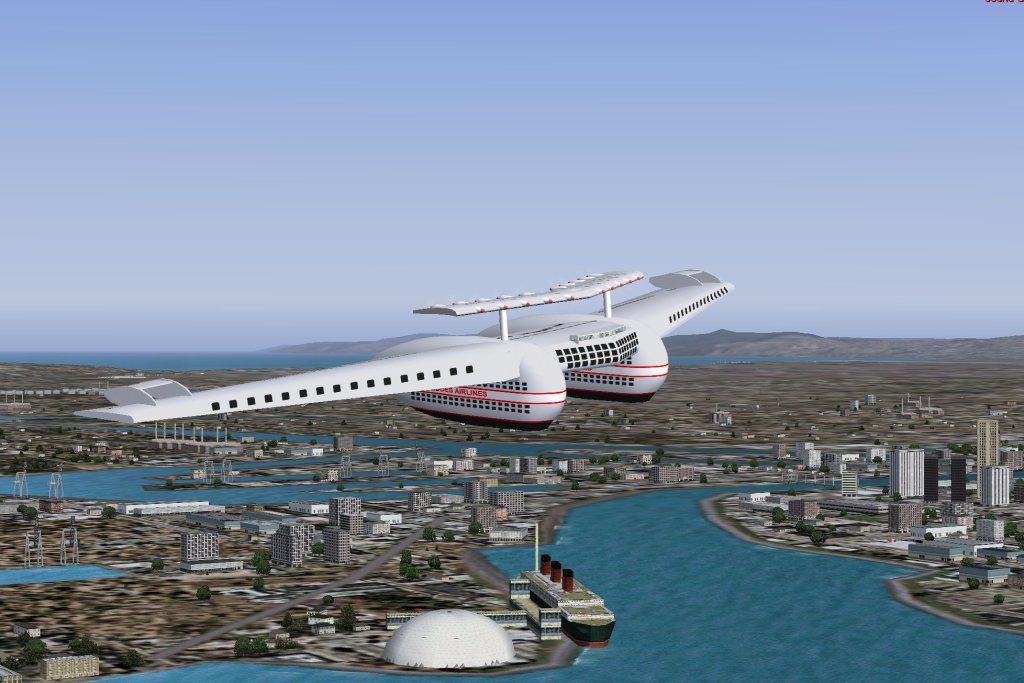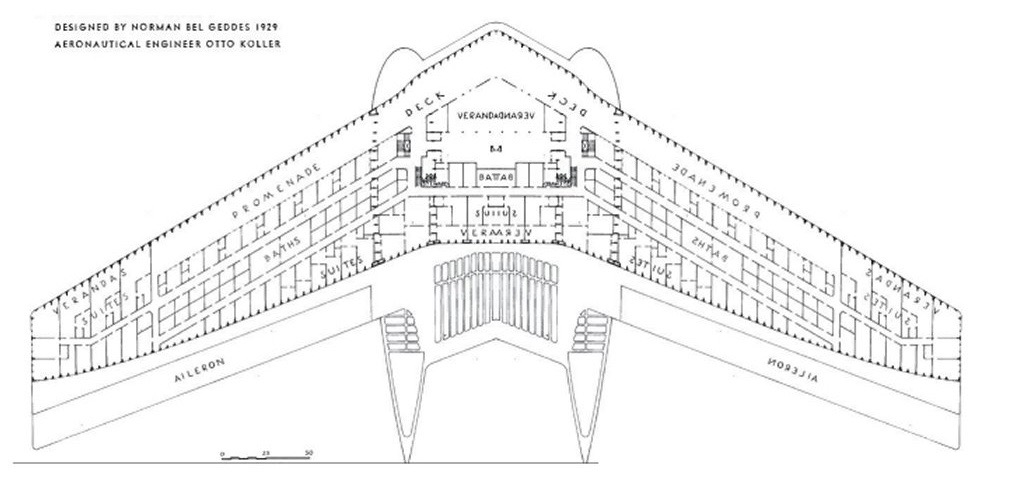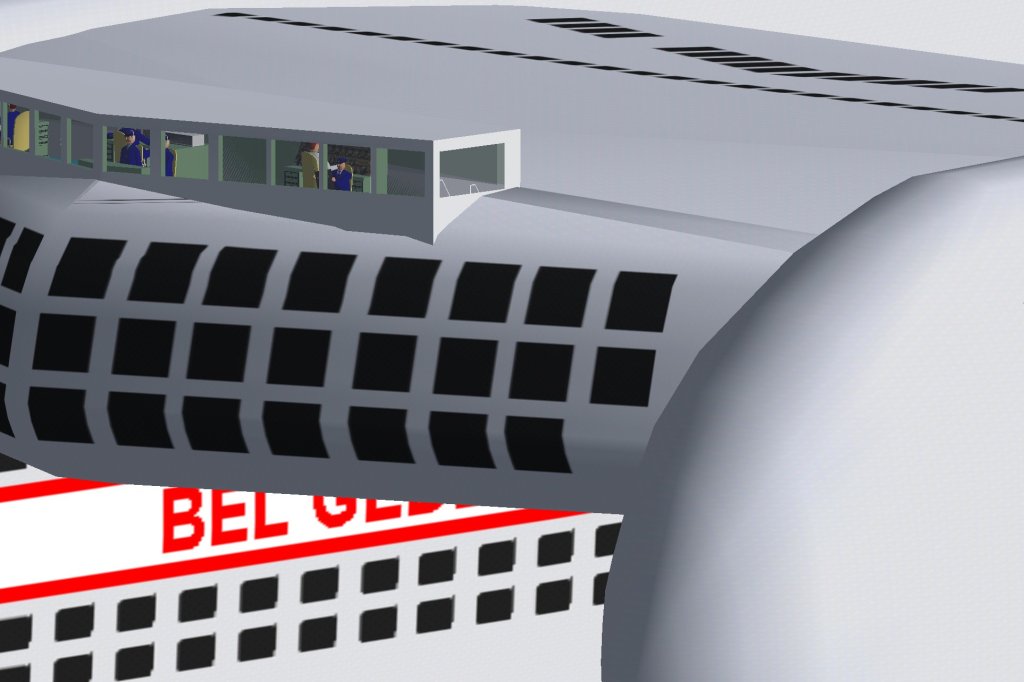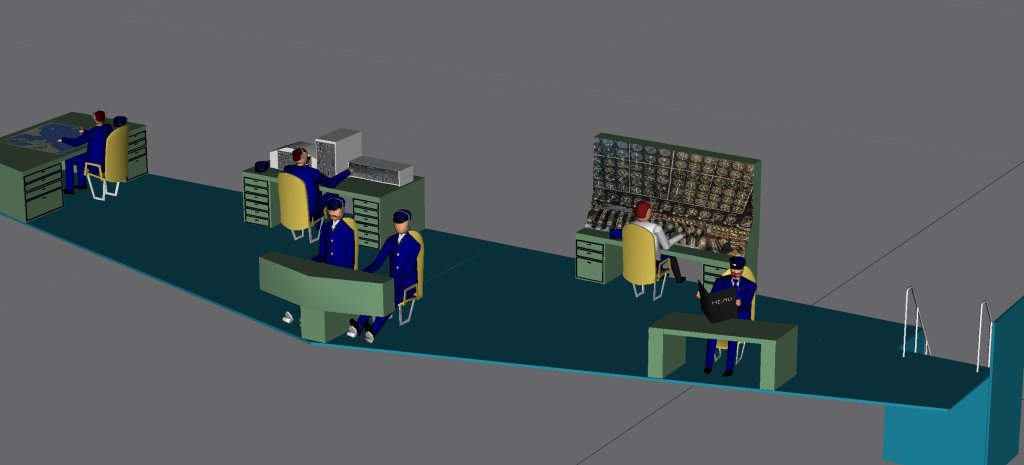Simanaitis Says
On cars, old, new and future; science & technology; vintage airplanes, computer flight simulation of them; Sherlockiana; our English language; travel; and other stuff
BEL GEDDES AIRLINER NUMBER 4 PART 2
NORMAN BEL GEDDES had a grand design evolving between 1929 and 1932: His Airliner Number 4 was envisioned as a flying hotel traveling non-stop between Chicago and London in 42 hours. Here in Part 2, we discuss technicalities of this giant aircraft, together with details of my rendering the craft in GMax for Microsoft Flight Simulator.
A Vast Design. Norman Bel Geddes wasn’t aeronautically trained, but he collaborated with Otto A. Koller, a German aeronautical engineer. Indeed, they disagreed about details of an earlier design study; according to Wikipedia, Koller described Airliner Number 1 as “an absolute[ly] undesirable design.” Nor did Koller provide performance specifications for Airliner Number 4, which received extensive coverage in Bel Geddes’ book Horizons, 1931. Wikipedia notes, “Geddes devoted over ten pages of the book to the project, including a fulsome endorsement of Koller’s skills as an aircraft engineer….”

The Bel Geddes Number 4’s wing span was to be 528 ft. 5 in. To put this in perspective, a Boeing 747-8’s span is less than half this, at 224 ft. 7 in. Whereas this largest of 747 variants has a Maximum Takeoff Weight of 987,000 lb., the Bel Geddes’ MTOW was a designed 1,275,300 lb.
Bel Geddes Power. Twenty engines, each producing 1900 hp, were located on a separate dual-pillar-mounted wing. Ten operated tractor-fashion; ten, pusher.
These engines were accessible through elevators in the pillars and channels in the upper wing. Maintenance could be carried out in situ, or engines could be transported by rail to the craft’s machine shop. If necessary, a powerplant could be replaced with one of six engines held in reserve.
According to flyawayssimulation.com, calculations indicated that a cruising speed could be maintained with only 12 engines in operation. All 20 gave a climb to 10,000 ft. in one hour, with a cruising speed of 87.5 mph at that altitude. Range was figured at 7500 miles, with an air refueling over Newfoundland as part of the Bel Geddes’ Chicago-London non-stop service.
Amphibious Operation. The Bel Geddes’ dual pontoons were designed for water-based operation, with an amphibious option.

As emergency measures, the pontoons carried six 40-ft. lifeboats, each capable of carrying 110 people. To seek help in an emergency, the design also carried two small seaplanes with folded wings; each could be dispatched on the water or while in flight.
The Bel Geddes Crew. The airliner’s flight crew had a Captain, Mate, four Seamen, two Pilots, two Navigators, two Radio Operators, two Electricians, a Chief Engineer, two Engineers, and seven Mechanics.
Crew members addressing the needs of passengers included a Purser; a Cashier; two Telephone Operators; two Clerks; a Stenographer; a Librarian; a Baggage Master; two Baggage Men; a Chief Steward; a Chief Dining Room Steward; two Head Waiters; two Wine Stewards, 24 Waiters, and seven Bus Boys; a Chief Bar Steward; nine Bartenders; a Chief Deck Steward; six Deck Stewards; a Chef; six Cooks; two Dishwashers; 24 Room Stewards; 16 Room Stewardesses; a Doctor; a Nurse; and seven Musicians. And don’t forget those staffing the gym, solaria, barbershop, salon, children’s playroom, and gift shop.

Indeed, the Bel Geddes Number 4 was a luxury hotel that would fly between the American Midwest and England.

My GMax Model of the Bel Geddes Number 4. The Bel Geddes’ shapes were easily formed using GMax modifications of its Box, Cylinder, and Sphere Primitives. Unlike my vintage aircraft modeling, Bel Geddes details are enveloped within these surfaces. Also, modeling details such as its 20 powerplants and props are easy-peasy through GMax cloning.
It wasn’t until rendering of the Bel Geddes flight deck that my GMax modeling got interesting, if not completely out of hand. I had no documentation of the flight deck, only an accounting of its crew and their responsibilities. I opted for showing the Captain, Pilot, Copilot, Chief Engineer, and one each of the Navigators and Radio Operators. Again, cloning gave me easy fabrication of each, though I had fun mixing and matching crew members (and faces) of earlier craft. As a final fillip, I figured my Captain had nothing better to do that peruse a Menu.
A Gargoyle Analogy. Of course, these crew members are all but invisible in the vastness of the Bel Geddes Airliner Number 4. The Navigator, for instance, uses the GMax Tick18 animation (intended for rotating beacons): He’s writing calculations on a chart of the Chicago/London aerial route. The Engineer and Radio Operator appear to be adjusting one thing or another. And, of course, the Pilot’s controls are GMax-animated.


All this GMax fiddling is similar to that of the sculptor carving gargoyles way up on a cathedral, where they’ll be admired only from afar. Akin to that sculptor, though, I derive pleasure from knowing the Bel Geddes’ crew is hard at work (even if I chose not to render the women’s solarium and its masseuse).
GMax is a great time-gobbling hobby, but Geez. ds
© Dennis Simanaitis, SimanaitisSays.com, 2021
One comment on “BEL GEDDES AIRLINER NUMBER 4 PART 2”
Leave a comment Cancel reply
This site uses Akismet to reduce spam. Learn how your comment data is processed.
Information
This entry was posted on January 17, 2021 by simanaitissays in Computer Flight Sim, Vintage Aero and tagged gargoyle analogy (artistic work not readily seen again), GMax model Bel Geddes Airliner Number 4, list of crew Bel Geddes Airliner Number 4, Norman Bel Geddes Airliner Number 4, Otto A. Koller (aeronautical engineer working with Bel Geddes on Airliner Number 4.Shortlink
https://wp.me/p2ETap-bfeCategories
Recent Posts
Archives
- May 2024
- April 2024
- March 2024
- February 2024
- January 2024
- December 2023
- November 2023
- October 2023
- September 2023
- August 2023
- July 2023
- June 2023
- May 2023
- April 2023
- March 2023
- February 2023
- January 2023
- December 2022
- November 2022
- October 2022
- September 2022
- August 2022
- July 2022
- June 2022
- May 2022
- April 2022
- March 2022
- February 2022
- January 2022
- December 2021
- November 2021
- October 2021
- September 2021
- August 2021
- July 2021
- June 2021
- May 2021
- April 2021
- March 2021
- February 2021
- January 2021
- December 2020
- November 2020
- October 2020
- September 2020
- August 2020
- July 2020
- June 2020
- May 2020
- April 2020
- March 2020
- February 2020
- January 2020
- December 2019
- November 2019
- October 2019
- September 2019
- August 2019
- July 2019
- June 2019
- May 2019
- April 2019
- March 2019
- February 2019
- January 2019
- December 2018
- November 2018
- October 2018
- September 2018
- August 2018
- July 2018
- June 2018
- May 2018
- April 2018
- March 2018
- February 2018
- January 2018
- December 2017
- November 2017
- October 2017
- September 2017
- August 2017
- July 2017
- June 2017
- May 2017
- April 2017
- March 2017
- February 2017
- January 2017
- December 2016
- November 2016
- October 2016
- September 2016
- August 2016
- July 2016
- June 2016
- May 2016
- April 2016
- March 2016
- February 2016
- January 2016
- December 2015
- November 2015
- October 2015
- September 2015
- August 2015
- July 2015
- June 2015
- May 2015
- April 2015
- March 2015
- February 2015
- January 2015
- December 2014
- November 2014
- October 2014
- September 2014
- August 2014
- July 2014
- June 2014
- May 2014
- April 2014
- March 2014
- February 2014
- January 2014
- December 2013
- November 2013
- October 2013
- September 2013
- August 2013
- July 2013
- June 2013
- May 2013
- April 2013
- March 2013
- February 2013
- January 2013
- December 2012
- November 2012
- October 2012
- September 2012
- August 2012

Lordy! What a monster …